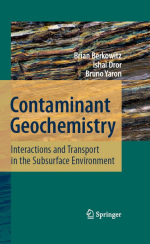Добрый день, Коллеги. Важное сообщение, просьба принять участие. Музей Ферсмана ищет помощь для реставрационных работ в помещении. Подробности по ссылке
Contaminant geochemistry. Interactions and transport in the subsurface environment / Геохимия загрязнения. Взаимодействия и транспорт в близповерхностной среде
The zone between land surface and the water table, which forms the upper boundary of the groundwater region, is known as the vadose zone. This zone is mostly unsaturated—or more precisely, partially saturated—but it may contain a saturated fraction in the vicinity of the water table due to fluctuations in water levels or capillary rise above the water table. The near-surface layer of this zone—the soil—is generally partially saturated, although it can exhibit periods of full saturation. Soil acts as a buffer that controls the flow of water among atmosphere, land, and sea and functions as a sink for anthropogenic contaminants.
Soil forms from the disintegration or decomposition of parent rock material, due to weathering processes and decomposition of organic materials. The mineral fraction of soil is formed by physical weathering of rock, resulting from thermal expansion of minerals along crystallographic axes or expansion of water in rock fissures. Stable weathering products from mineral decomposition may consist of ionic or neutral organic and inorganic components, solid organic residues, and newly formed silicates, oxides, hydroxides, carbonates, sulfides, and other solids (Greenland and Hayes 1978). The organic fraction of soil is an heterogeneous mixture of products resulting from microbial and chemical transformation of nonliving organic residues, plant roots, and living microorganisms. <...>




